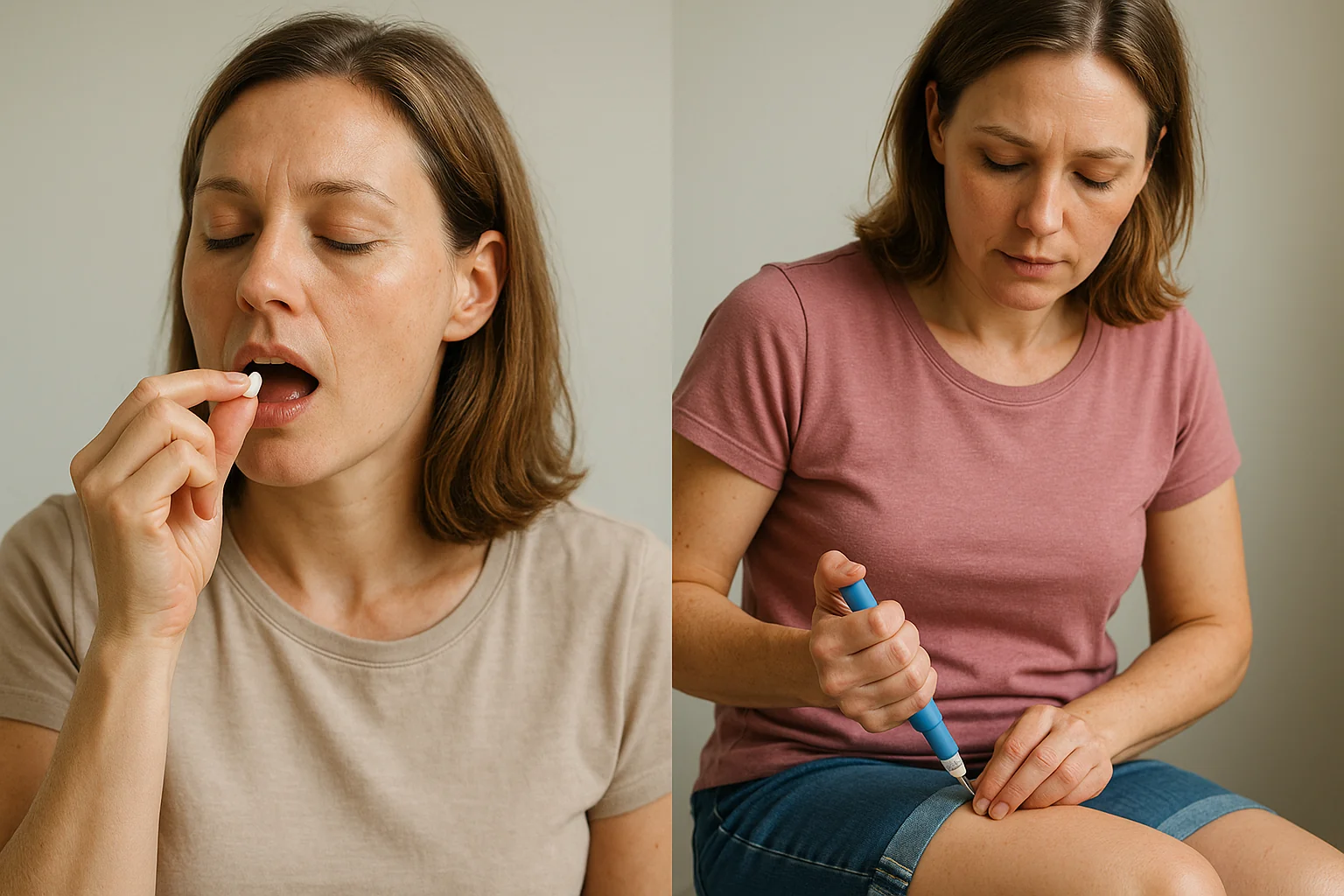A 2 minute assessment to get a personalized mental health or alcohol recovery plan.
Wondering how tried and true naltrexone compares to the new GLP-1 medications for curbing alcohol cravings. Use this breakdown for a clear idea of how the medications compare for treating alcohol use disorder.
What You’ll Learn:
- What the two medications were originally developed to treat.
- How naltrexone and GLP-1 works.
- Each medication’s success rate for reducing alcohol cravings and consumption.
- How the side effects of naltrexone and GLP-1 compare.
In recent years, pharmacological management medications have come to the forefront in a big way for a wide variety of mental health disorders. As the country finally acknowledges the growing mental health crisis, people are more open to trying new therapies and making them more readily available to the masses. We recognize that for many people, cognitive behavioral therapy and support groups aren’t enough to overcome issues like alcohol use disorder (AUD).
Two medications that have gained a lot of attention for AUD are naltrexone and glucagon-like peptide 1 (GLP-1) semaglutide medications. Naltrexone has been called the Ozempic for alcoholism, but it turns out Ozempic itself may be a viable treatment option as well. While there’s evidence both can help curb alcohol cravings and consumption they work in different ways as you will discover in this comparative review.
Development and Approved Uses
Naltrexone
Naltrexone was developed in 1984 for the treatment of opioid use disorder. It was later discovered through testing that naltrexone is also effective at treating alcohol use disorder by reducing alcohol cravings through its effects on the brain’s reward system. Naltrexone tablets were FDA-approved as a treatment for alcohol use disorder in 1994.
GLP-1
GLP-1 receptor antagonist medications (semaglutides) are primarily known as a weight loss medication that was developed to help obese individuals get within a healthy body mass index (BMI). It’s also used to treat Type 2 diabetes since it releases insulin and helps control blood sugar levels, which was the first reason GLP-1 medications were approved for use in 2005. They were later FDA-approved for weight loss in 2014.
How They Work: Physiological Versus Psychological
Naltrexone - A Psychological Process
When naltrexone was first tested for opioid use disorder it was discovered that the medication has a psychological effect. Naltrexone works by blocking opioid receptors that release dopamine and create euphoric effects. When the psychological benefits of alcohol are blunted, it helps to reduce cravings by eliminating the positive association. As a result, a person simply becomes less interested in drinking alcohol.
Medication Administration: Naltrexone is a once daily tablet that is taken orally.
GLP-1 - A Physiological Process
Researchers are still trying to nail down exactly how GLP-1 antagonist receptors work to reduce alcohol cravings and consumption, but the theory is that it works for the same reason that it leads to weight loss. GLP-1 is a hormone that acts as an appetite suppressant, which could be why semaglutides suppress alcohol cravings. GLP-1 semaglutide medication mimics the GLP-1 hormone that is known to increase feelings of fullness and slows gastric emptying, further increasing the feeling of fullness.
Medication Administration: GLP-1 medications are administered via a daily or weekly injection.
Success Rates For Reducing Alcohol Use
Naltrexone
Many studies have shown that naltrexone is effective at increasing the days of abstinence and reducing heavy-drinking days by 80.6% and 66.2% respectively. It’s also been shown to reduce alcohol use by more than 90% for 70.8% of people.
GLP-1
Currently, there are a number of studies being conducted to specifically look at GLP-1 semaglutides’ ability to reduce alcohol use. The initial research is finding that it does appear to reduce alcohol use.
There have been a number of observations of this during previous studies that gauge the effectiveness of GLP-1 medications for diabetes and weight loss. While GLP-1 appears to be effective for reducing alcohol consumption, there is still research to be done to cite specific success rates.
Potential Side Effects
Naltrexone
The likelihood of experiencing side effects from naltrexone are low. Data collected in studies show that the most common side effect, nausea, is experienced by 9-35% of people. It tends to happen at the start of treatment and subsides within hours or days of beginning use. The side effects are also usually dose dependent.
The most common side effects with naltrexone are:
- Nausea
- Vomiting
- Headaches
- Fatigue
- Heightened Anxiety
- Abdominal Pain
- Dizziness
- Muscle pain
- Joint pain
- Constipation
- Diarrhea
- Appetite Loss
- Insomnia
- Sleep Disturbances
Serious side effects that are much less likely include:
- Liver Damage
- Depression
- Allergic Reaction
GLP-1
The side effects for GLP-1 medications are very similar to naltrexone. The ones that are most likely to occur (vomiting and nausea) typically occur when treatment is first started and then subside quickly.
Common GLP-1 side effects include:
- Nausea
- Vomiting
- Diarrhea
- Constipation
- Abdominal Pain
- Hypoglycemia
Side effects that are less likely include:
- Pancreatitis
- Gallbladder Problems
- Joint Pain
- Headaches
- Upper Respiratory Infections
With GLP-1 the effects of long-term use are still not well researched. There’s also little research on the side effects for people with average to below average body mass index (BMI).
Choose Your Horizon is a telehealth platform that is dedicated to helping people gain access to all viable treatment options for alcohol use disorder. We currently help patients receive naltrexone prescriptions so that they can take control of their drinking whether that entails simply reducing consumption or binge drinking, or if it means abstaining from alcohol long-term.
We offer an Alcohol Use Assessment test online to help people get a better idea of what treatment options are possible.




